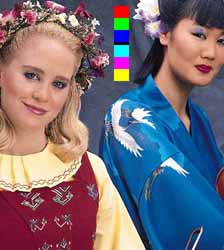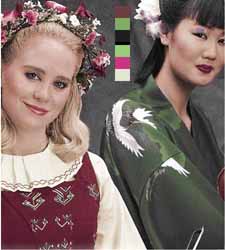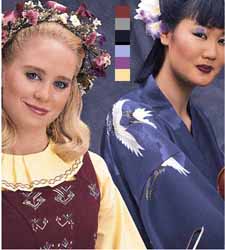Colour prediction models are useful for populating the color calibration tables of printing devices. These
tables convert input colors, for instance calibrated RGB or CIE-XYZ, into coverages of Cyan, Magenta, Yellow and
Black inks. Without prediction model, one needs to measure the CIE-XYZ colorimetric values of a large number of
patches (several hundreds) in order to fill the calibration tables by interpolating between the acquired pairs of
XYZ-CMY values. The relation between colorimetric values and amounts of cyan, magenta, yellow inks is highly
non-linear and depends on many different parameters: the spectra of the inks, the properties of the paper, the
halftoning method, ink spreading, etc.. Hence, new calibrations needs to be performed whenever any of these
parameters is changed, e.g. when printing with a different paper, a different ink cartridge or a different
halftoning algorithm. Color prediction models allow to populate printer calibration tables by measuring just a few
patches and therefore greatly facilitate the calibration process. Next generation of printers will be equipped
with sensors for the acquisition of reflection spectra or of colorimetric values. This will enable printers to
perform automatic recalibration. A similar approach may be applied for the calibration of printers printing with
custom inks (inks which are different from standard cyan, magenta and yellow inks).
The proposed new spectral reflection model
enhances the classical Clapper-Yule model by taking into account the fact that proportionally more incident
light through a given colorant surface is reflected back onto the same colorant surface than onto other colorant
surfaces. It comprises a weighted mean between a component specifying the part of the incident light which exits
through the same colorant as the colorant from which it enters (Saunderson corrected Neugebauer component) and a
component specifying the part of the incident light whose emerging light components exit from all colorants
(Clapper-Yule component). We also propose models for taking into account ink spreading, a phenomenon which occurs
when printing an ink halftone in superposition with one or several solid inks. The ink spreading model
incorporates nominal to effective surface coverage functions for each of the different ink superposition
conditions. A system of equations yields the effective ink surface coverages of a color halftone as a weighted
mean of the ink surface coverages specific to the different superposition conditions. The new spectral reflection
prediction model combined with the ink spreading model yields excellent spectral reflection predictions for
clustered-dot color halftones printed on an offset press or on thermal transfer printers.
Dot gain is different when dots are printed alone, printed in superposition with one ink or printed in
superposition with two inks. In addition, the dot gain may also differ depending on which solid ink the considered
halftone layer is superposed. In a previous research project, we developed a model for computing the effective
surface coverage of a dot according to its superposition conditions. In the present contribution, we improve the
Yule-Nielsen modified Neugebauer model by integrating into it our effective dot surface coverage computation
model. Calibration of the reproduction curves mapping nominal to effective surface coverages in every
superposition condition is carried out by fitting effective dot surfaces which minimize the sum of square
differences between the measured reflection density spectra and reflection density spectra predicted according to
the Yule-Nielsen modified Neugebauer model. In order to predict the reflection spectrum of a patch, its known
nominal surface coverage values are converted into effective coverage values by weighting the contributions from
different reproduction curves according to the weights of the contributing superposition conditions. The improved
YNSN yields excellent predictions for clustered dot haltones in the case of offset, thermal transfer, ink-jet
technologies.
We developed a unified spectral prediction
model relying on a two flux approach (Kubelka-Munk), describing in a single mathematical expression the
reflection of light on one or several uniform ink layers, both for transparent and partially opaque inks.This
model takes into account the surface reflection at the interface between the air and the paper, light absorption
in the ink layers, light scattering and reflection within the paper bulk and the internal reflections at the
print-air interface. The model is extended to halftone ink layers by modeling lateral light scattering with a
convolution function. The presented approach unifies the classical models within a new mathematical framework
based on matrices.
Printing with custom inks is of interest both for artistic purposes and for printing security documents such
as banknotes. However, in order to create designs with only a few custom inks, a general purpose high-quality
gamut reduction technique is needed. Most existing gamut mapping techniques map an input gamut such as the gamut
of a CRT display into the gamut of an output device such as a CMYK printer. In the present contribution, we are
interested in printing with up to three custom inks, which in the general case define a rather narrow color gamut
compared with the gamut of standard CMYK printers. The proposed color gamut reduction techniques should work for
any combination of custom inks and have a smooth and predictable behavior [Chosson02, Chosson03].
When the black ink is available, the lightness levels present in the original image remain nearly identical.
Original colors with hues outside the target gamut are projected onto the gray axis or onto desaturated colors.
Original colors with hues inside the target gamut hues are rendered as faithful as possible.
When the black ink is not available, we map the gray axis G into a colored curve G' connecting in the 3D color
space the paper white and the darkest available color formed by the superposition of the 3 inks.
The mapped gray axis curve G' is given by the Neugebauer equations when enforcing equal amounts of custom inks.
After lightness mapping, hue and saturation mappings are carried out. When the target gamut does not
incorporate the gray axis, we divide it into two volumes, one on the desaturated side of the mapped
gray axis curve G' and the other on the saturated side of the G' curve. Colors whose hues are not
part of the target color gamut are mapped to colors located on the desaturated side of the G' curve.
Colors within the set of printable hues remain within the target color gamut and retain as much as
possible their original hue and saturation.

Original image
mapped
onto 4 different target color gamuts : |

 |
two custom inks
and the black ink |
|

 |
three custom inks
and the black ink |
|
|

 |
three custom inks
without black |
|

 |
three custom inks
without black |
|
![[Overview]](../../share/look/Overview.jpg)
![[Research]](../../share/look/Research.jpg)
![[Teaching]](../../share/look/Teaching.jpg)
![[Publications]](../../share/look/Publications.jpg)
![[Staff]](../../share/look/Staff.jpg)






